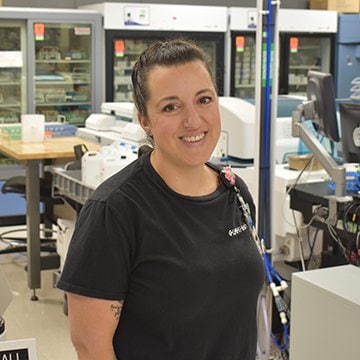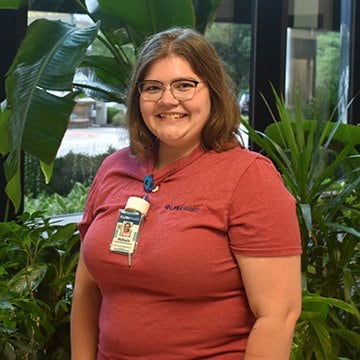Following a variety of paths leads to jobs in healthcare
The healthcare industry offers a diverse array of career paths, encompassing administrative and clinical positions in multiple specialties and areas of care. The pathway to entering the clinical side of healthcare does not have to be through a traditional four-year college degree or a doctorate, but rather it can be through on-the-job training, vocational certifications or an associate’s degree.
Phlebotomy
A phlebotomist is trained to draw blood samples and prepare them to be tested and analyzed. They primarily work in hospitals, labs, clinics and blood donation centers. Everyday tasks for phlebotomists include:
- Preparing and labeling collection vials
- Preparing patients for blood draws
- Performing blood draws
- Maintaining blood draw instruments and supplies

Nicholina Chronister
Individuals who are interested in becoming a phlebotomist can receive on-the-job training or through an in-person or online certification. Most LMH Health phlebotomists received on-the-job training after being hired.
“The hardest part about completing my phlebotomy training was being afraid to hurt my patients,” said Nicholina Chronister, LMH Health phlebotomy supervisor.
Chronister, a former wildfire firefighter, was seeking a career change that would allow her to enter the healthcare industry. She wanted to get her foot in the door to see if a career in emergency medicine was right for her. Phlebotomy was a great way for her to get hands-on experience without investing time and money in a specialized degree.
“I know of a few people who used phlebotomy as a way to kick start their career,” said Chronister. “Some of them have gone on to become registered nurses, therapists or achieve higher levels of education.”
Chronister began her career with LMH Health in 2011 after she connected with a phlebotomist during an emergency department visit. She received additional training in administrative and laboratory processes and progressed to become the phlebotomy supervisor in 2019.
“I fell in love with phlebotomy and how important and impactful it is to patient care,” Chronister said. “Our work influences treatment plans, provides answers, and gets patients on the road to recovery.”
Think of the healthcare industry as a beehive and every position within it as a different bee. Each position has a role that impacts how other healthcare professionals respond and work. Chronister likens phlebotomists to the worker bees of the hive, but instead of collecting pollen, they draw blood.
“We are a part of a large system and it is important that we do our tasks in a timely manner so that our lab can do theirs without rushing,” Chronister said.
Phlebotomy is a fast-paced career that has a lot of interaction with patients. A phlebotomist needs to be good with people, pay good attention to detail, be self-motivated and driven.
“When we are looking at phlebotomist applications, we aren’t always looking for previous healthcare experience,” Chronister said. “Oftentimes, we are looking for the candidates who have no experience, but are willing to learn and adapt on the job.”
Medical assistant
A certified medical assistant (CMA) is an advanced form of a certified nurse’s assistant (CNA). They work closely with nurses, providers and doctors in clinics and medical offices. A CMA is responsible for handling administrative and clinical tasks and are often the first line of contact for patients when receiving care. These professionals are responsible for:
- Obtaining medical histories and personal information
- Taking and recording patient’s vital signs, such as height, weight, temperature, etc.
- Preparing patients for examination
- Instructing patients in follow up care
- Scheduling appointments
- Updating patient medical records

MaKayla Hastings
Individuals who want to become an MA do not have to begin as a CNA, as the CMA training course is open to everyone. The only requirement for entering a Certified Medical Assistant (CMA) program is a high school diploma or a GED. Once an individual has completed the program, they are required to take the Certified Medical Assistant test through the American Association of Medical Assistants. After they have passed and are certified, they are now able to be employed in clinics, hospitals, nursing homes, diagnostic labs and more.
MaKayla Hastings, a medical assistant with Cardiovascular Specialists of Lawrence, began as CNA. During the height of COVID, Hastings applied to the CMA program through Peaslee Tech and participated in the LMH Health reimbursement program.
LMH Health employees who have completed the 90-day introductory period and have 20 or more agreed hours per week are eligible for tuition reimbursement for selected courses, such as CMA, sterile processing and coding, through Peaslee Tech. Employees who participate in the Peaslee Tech tuition reimbursement program commit to one year of employment with LMH Health following completion of the course.
“Becoming a CMA allowed me to receive a pay raise and the course was more of a review since I had completed my CNA,” said Hastings.
The CMA is composed of two sections, medical technology and a practical for anatomy, vitals and medication. At Peaslee Tech, students have a year to complete the course at their own pace.
“I had a coworker who did it in 3 months, but I took the whole year,” said Hastings. “The hardest part for me was making sure I set aside time to sit down and do it.”
Hastings was able to complete her practical training on the job at LMH Health. Individuals interested in pursuing a CMA or a higher level of certification, such as an RN, should be able to work in a fast-paced environment, pay attention to detail and have a willingness to problem-solve.
“The medical field can be hard, but as a CMA you learn that a lot of aspects it can be really worthwhile when you know you are helping someone,” said Hastings.
CMAs are able to use their training and experiences to pursue a degree in nursing or in other areas of healthcare.
Biomedical technician
Not every position in the healthcare industry requires patient contact. Biomedical technicians work behind the scenes to keep hospital and clinic equipment up and running. Depending on the scale of the organization they are employed with, these technicians can service up to more than 2,500 unique pieces of equipment.
Some of the daily tasks of biomedical technicians include:
- Installing, maintaining and repairing medical equipment
- Performing routine tests and inspections of equipment
- Performing preventive maintenance
- Identifying parts and equipment for removal or replacement
- Maintaining records of equipment replacement, repairs and maintenance

Curtis Weilert
“You don’t get bored. Every day there is a new surprise,” said Curtis Weilert, LMH Health biomedical technician. “I often find myself asking, ‘What’s this piece of equipment and what does it do?’”
There are two common ways to enter the biomedical field. The first is through an associate’s degree with a focus in computer sciences, engineering or biomedical and the second is through a military biomedical program.
Weilert earned an associate’s degree in Electronics and Computer Engineering Technology from Grantham University. He completed all of his general education credits through a community college to lower the cost, later transferring to a specialized online college for the core electronic credits.
“While working for a wind farm on wind towers, I decided it was time to get out of that business,” said Weilert. “My experience was in electronics, but I did not know a lot about the biomed aspect. I was able to learn the biomed aspect on the job.”
Individuals interested in pursuing a career as a biomedical technician should have an interest in how and why things work, as well as a basic knowledge of logic and troubleshooting and mechanical sciences.
“BioMed is a hidden gem within healthcare,” exclaimed Weilert. “You get to move around and get your hands on lots of different equipment.”
Sometimes the biggest challenge biomedical technicians face in a larger healthcare setting is finding the equipment. LMH Health has over 6,000 pieces of equipment spread across multiple cities and clinics. Due to the quantity of equipment and the fact that some only need routine maintenance, LMH Health biomedical technicians may only touch a piece once each year. This results in the techs having to reacquaint and re-learn the equipment constantly.
“I had to restart at 47 after ten years working with family,” stated Weilert. “I turned towards the wind farm and then to BioMed. Even at that age I was able to start over, learn new things, finish my associate’s degree, and start a new career. If I can do it, anybody else can.”
You can't define it, but you know it when you see it: the difference between an average life and the good life. When your cup is full – with joy, purpose and lifelong health – it shows. At LMH Health, we are all about healthy people, healthy communities and healthy futures, and that makes us your destination for an exceptional career. From flexible, work-life harmony to competitive pay and great advancement potential, find everything you're looking for at LMH Health.
We're looking for you.